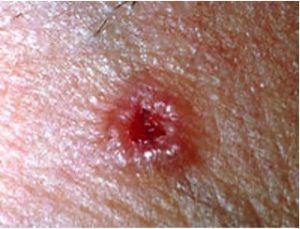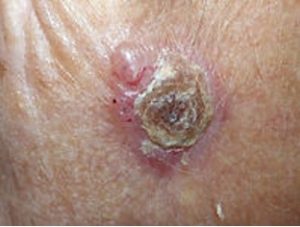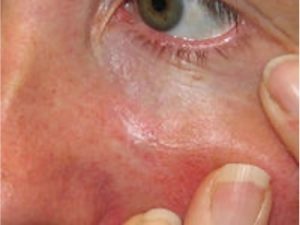Kalamunda Skin clinic at Mead Medical specialise in Skin cancer:
- Detection
- Management
- Surveillance
- Prevention
Australia and New Zealand have the highest rates of skin cancer in the world.
Types of cancer
Skin cancers come in three main varieties:
- Basal Cell carcinoma (BCC)
- Squamous cell carcinoma (SCC)
- Malignant melanoma.
Malignant melanoma are particularly unpredictable. Although they have recently been linked to 10 or more visits to the sun bed and UV sun exposure, they also can occur in parts of the body which do not see the sun. Melanomas if not detected early can invade the blood stream, and appear in other areas of the body (metastases).
Some facts from Cancer Council Australia:
- Skin cancers account for around 80% of all newly diagnosed cancers.
- 66% of Australians will be diagnosed with skin cancer by the time they are 70.
- 434,000+ people are treated for one or more non-melanoma skin cancers in Australia each year.
- 2,046 people died from skin cancer in Australia in 2012, when the most recent statistics were taken.?
We know that skin cancer can occur at any age, and in any skin type and colour.
Skin Cancer Does not discriminate!
Basal Cell Carcinoma (BCC) is a non-melanoma skin cancer that starts in the basal cells of the lower layer of the epidermis.
Basal Cell Carcinoma is the most common type of Keratinocyte cancer and accounts for 70% of non-melanoma skin cancers.
How is Basal Cell Carcinoma caused?
Basal cells shed as new ones form, when DNA is damaged from exposure to ultraviolet (UV) radiation, basal cells are triggered, resulting in uncontrolled growth.
Risk Factors
- UV exposure from the sun or indoor tanning
- Fair Skin
- History of Skin Cancer
- Aged 50 years and over
- Male Gender
- Skin injuries, inflammation or infection
Superficial Basal Cell Carcinoma
Scaly & irregular plaque
Nodular Basal Cell Carcinoma
Shiny or pearly nodule
Basosquamous Basal Cell Carcinoma
mixed BCC and SCC
Morphoeic Basal Cell Carcinoma
waxy yellow/white scar
Investigations
- Skin checks 3-12 monthly
- Skin Biopsy Surgery
- Histopathology analysis
Treatment Options
- Surgical Excision
- Photo Dynamic Therapy (PDT)
- Cryotherapy
- Cautery and Curettage
- Aldara
Keys facts about MELANOMA;
- Malignant Melanoma (MM) is the least common but, the most dangerous of all the skin cancers.
- It accounts for majority of skin cancer deaths.
- MM readily spreads to other organs in the body, such as the brain, bones, liver, lungs, and bowel.
- Not all melanomas are easy to identify, even by experienced eyes. Melanomas although are often pigmented, can also be non-pigmented (amelanotic).
- Melanoma develops from a pre-existing mole only 50% of the time.
- Some skin conditions such as; Dysplastic nevus syndrome, can increase the risk of developing Melanoma.
- Melanoma can occur at any age, though is very rare before puberty. Despite this, we encourage that if there is any question about any mole, at any age, we advise to have it checked.
- Family History of melanoma is IMPORTANT, as there is increasing genetic evidence within family lines.
- Melanoma, although often seen in areas of sun damage, can occur in areas that rarely see the sun. This is especially if there is any genetic predisposition.
- Melanoma can occur on ANY skin type. Although many people relate skin cancer to fairer skinned individuals, Melanoma is NOT exclusive. Bob Marley died of Malignant Melanoma under his toenail.
- If diagnosed EARLY, nearly all melanomas are CURABLE
When to get a SKIN CHECK, regardless of when your recall date for your next one is;
- New mole/ spot
- Changing/ growing mole
- Non-symmetrical
- A mole/spot that looks different from the others on your body
- Bleeding
- Ulcerating
- Peeling
- Tingling
- Painful to pinch/touch
Watch for:
New mole/spot
Changing, growing
Non-symmetry
Odd-one out
Bleeding
Ulcerating
Change in sensation
Tingling/Pain
EARLY detection = high CURABILITY
Surgical Skin Cancer and Mole Removal
Skin checks are aimed to detect skin cancer lesions earlier rather than later.
Sometimes we will be able to offer a non-surgical approach, for some types of early skin cancers. However, there will be times when we will suggest a surgical approach.
The main reasons for this are:
- Biopsy: to send a piece of tissue to the laboratory so specialty trained histological pathologists can examine it under the microscope. This tells us what it is, size, depth, and an indication of its nature (aggressive/non-aggressive).
- From this we can plan for Definitive surgery, where we aim to remove the complete cancer with normal skin margins surrounding it, as recommended by evidence-based guidelines. This minimises recurrence and optimises long term outcomes.
Some surgical methods include:
- Curettage and Cautery– For small, non-aggressive superficial cancers, a small circular blade (curette) is used to remove the cancer lesion and the tissue around it under local anaesthetic. The area is then burnt with a specialised device, to destroy any residual cancer cells.
- Cryosurgery– Liquid nitrogen is sprayed or held onto lesions with a cotton bud. This causes the destruction of the abnormal skin cells on the top layers of the skin. There will often be some resultant redness, itchiness, blistering and peeling of the treated skin. It is mainly used for small, pre-cancerous sun spots (solar keratoses/actinic keratoses).
- Simple Excision Skin Cancer Surgery– Very well tolerated and performed under local anaesthetic, the skin lesion is removed along with a small amount of surrounding skin. This skin is sent to our laboratory for analysis.
- Wide Excision Skin Cancer Surgery– A wider and deeper excision to remove an additional portion of the normal skin surrounding the lesion is utilised to minimise cancer recurrence and optimise long term outcome. This is the gold-standard treatment for melanoma.
- Flap or graft closure– Some parts of the body such as the face, scalp or lower leg, may require using a flap or a skin graft. A flap is a technique where nearby skin is moved to help cover a place where the lesion has been removed. A skin graft may be a partial or full-thickness section of normal skin removed from another part of the body, and placed on the defect resulting from the removal of the skin cancer. Our experienced nursing staff assist in changing your dressings until complete healing.
Usually surgery will be curative and no further treatment, apart from regular skin-checks, may be necessary.
Factors to consider for Skin Cancer Surgery:
A variety of factors are used to determine whether or not a patient is a good candidate for skin cancer surgery. Beyond general health, our doctors consider:
- Type of tumour
- Size and location
- Grade and stage of tumour
- Patient’s medical conditions
- Patient’s age
- Patients Allergies/Medications
We work with you presenting all options for treatment of your skin cancer and aim to make sure you are comfortable every step of the way.
Kalamunda Skin Clinic
Kalamunda Skin clinic at Mead Medical specialise in Skin cancer:
- Detection
- Management
- Surveillance
- Prevention
Australia and New Zealand have the highest rates of skin cancer in the world.
Types of cancer
Skin cancers come in three main varieties:
- Basal Cell carcinoma (BCC)
- Squamous cell carcinoma (SCC)
- Malignant melanoma.
Malignant melanoma are particularly unpredictable. Although they have recently been linked to 10 or more visits to the sun bed and UV sun exposure, they also can occur in parts of the body which do not see the sun. Melanomas if not detected early can invade the blood stream, and appear in other areas of the body (metastases).
Some facts from Cancer Council Australia:
- Skin cancers account for around 80% of all newly diagnosed cancers.
- 66% of Australians will be diagnosed with skin cancer by the time they are 70.
- 434,000+ people are treated for one or more non-melanoma skin cancers in Australia each year.
- 2,046 people died from skin cancer in Australia in 2012, when the most recent statistics were taken.?
We know that skin cancer can occur at any age, and in any skin type and colour.
Skin Cancer Does not discriminate!
Basal Cell Carcinoma (BCC) is a non-melanoma skin cancer that starts in the basal cells of the lower layer of the epidermis.
Basal Cell Carcinoma is the most common type of Keratinocyte cancer and accounts for 70% of non-melanoma skin cancers.
How is Basal Cell Carcinoma caused?
Basal cells shed as new ones form, when DNA is damaged from exposure to ultraviolet (UV) radiation, basal cells are triggered, resulting in uncontrolled growth.
Risk Factors
- UV exposure from the sun or indoor tanning
- Fair Skin
- History of Skin Cancer
- Aged 50 years and over
- Male Gender
- Skin injuries, inflammation or infection
Superficial Basal Cell Carcinoma
Scaly & irregular plaque
Nodular Basal Cell Carcinoma
Shiny or pearly nodule
Basosquamous Basal Cell Carcinoma
mixed BCC and SCC
Morphoeic Basal Cell Carcinoma
waxy yellow/white scar
Investigations
- Skin checks 3-12 monthly
- Skin Biopsy Surgery
- Histopathology analysis
Treatment Options
- Surgical Excision
- Photo Dynamic Therapy (PDT)
- Cryotherapy
- Cautery and Curettage
- Aldara
Keys facts about MELANOMA;
- Malignant Melanoma (MM) is the least common but, the most dangerous of all the skin cancers.
- It accounts for majority of skin cancer deaths.
- MM readily spreads to other organs in the body, such as the brain, bones, liver, lungs, and bowel.
- Not all melanomas are easy to identify, even by experienced eyes. Melanomas although are often pigmented, can also be non-pigmented (amelanotic).
- Melanoma develops from a pre-existing mole only 50% of the time.
- Some skin conditions such as; Dysplastic nevus syndrome, can increase the risk of developing Melanoma.
- Melanoma can occur at any age, though is very rare before puberty. Despite this, we encourage that if there is any question about any mole, at any age, we advise to have it checked.
- Family History of melanoma is IMPORTANT, as there is increasing genetic evidence within family lines.
- Melanoma, although often seen in areas of sun damage, can occur in areas that rarely see the sun. This is especially if there is any genetic predisposition.
- Melanoma can occur on ANY skin type. Although many people relate skin cancer to fairer skinned individuals, Melanoma is NOT exclusive. Bob Marley died of Malignant Melanoma under his toenail.
- If diagnosed EARLY, nearly all melanomas are CURABLE
When to get a SKIN CHECK, regardless of when your recall date for your next one is;
- New mole/ spot
- Changing/ growing mole
- Non-symmetrical
- A mole/spot that looks different from the others on your body
- Bleeding
- Ulcerating
- Peeling
- Tingling
- Painful to pinch/touch
Watch for:
New mole/spot
Changing, growing
Non-symmetry
Odd-one out
Bleeding
Ulcerating
Change in sensation
Tingling/Pain
EARLY detection = high CURABILITY
Surgical Skin Cancer and Mole Removal
Skin checks are aimed to detect skin cancer lesions earlier rather than later.
Sometimes we will be able to offer a non-surgical approach, for some types of early skin cancers. However, there will be times when we will suggest a surgical approach.
The main reasons for this are:
- Biopsy: to send a piece of tissue to the laboratory so specialty trained histological pathologists can examine it under the microscope. This tells us what it is, size, depth, and an indication of its nature (aggressive/non-aggressive).
- From this we can plan for Definitive surgery, where we aim to remove the complete cancer with normal skin margins surrounding it, as recommended by evidence-based guidelines. This minimises recurrence and optimises long term outcomes.
Some surgical methods include:
- Curettage and Cautery– For small, non-aggressive superficial cancers, a small circular blade (curette) is used to remove the cancer lesion and the tissue around it under local anaesthetic. The area is then burnt with a specialised device, to destroy any residual cancer cells.
- Cryosurgery– Liquid nitrogen is sprayed or held onto lesions with a cotton bud. This causes the destruction of the abnormal skin cells on the top layers of the skin. There will often be some resultant redness, itchiness, blistering and peeling of the treated skin. It is mainly used for small, pre-cancerous sun spots (solar keratoses/actinic keratoses).
- Simple Excision Skin Cancer Surgery– Very well tolerated and performed under local anaesthetic, the skin lesion is removed along with a small amount of surrounding skin. This skin is sent to our laboratory for analysis.
- Wide Excision Skin Cancer Surgery– A wider and deeper excision to remove an additional portion of the normal skin surrounding the lesion is utilised to minimise cancer recurrence and optimise long term outcome. This is the gold-standard treatment for melanoma.
- Flap or graft closure– Some parts of the body such as the face, scalp or lower leg, may require using a flap or a skin graft. A flap is a technique where nearby skin is moved to help cover a place where the lesion has been removed. A skin graft may be a partial or full-thickness section of normal skin removed from another part of the body, and placed on the defect resulting from the removal of the skin cancer. Our experienced nursing staff assist in changing your dressings until complete healing.
Usually surgery will be curative and no further treatment, apart from regular skin-checks, may be necessary.
Factors to consider for Skin Cancer Surgery:
A variety of factors are used to determine whether or not a patient is a good candidate for skin cancer surgery. Beyond general health, our doctors consider:
- Type of tumour
- Size and location
- Grade and stage of tumour
- Patient’s medical conditions
- Patient’s age
- Patients Allergies/Medications
We work with you presenting all options for treatment of your skin cancer and aim to make sure you are comfortable every step of the way.
Latest News
Welcoming patient feedback
How Mead Medical Responds to Patient Feedback At Mead Medical, we value every piece of
Welcoming Dr Emma Johnson to Mead Medical
We're thrill to introduce Dr Emma Johnson to Mead Medical from next week. Dr Johnson






